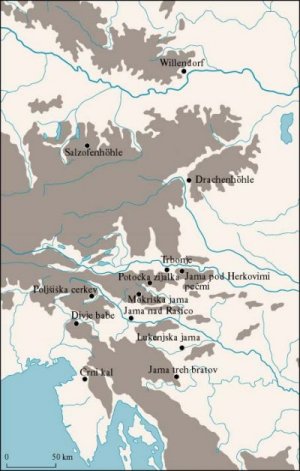|
FRAGMENTS OF ICE AGE ENVIRONMENTS
Fossil and subfossil remains of Capra ibex, L. from Salzofenhöhle (Upper Austria) and the Eastern Alpine region
Martina PACHER
|

Ibex sites included in the study.
|
Abstract
Fossil and subrecent Capra ibex is proved in many Austrian and Eastern Alpine caves but usually only few specimens were recovered. Salzofenhöhle (2005 m a.s.l.) provided a larger assemblage of ibex remains which was excavated between 1924 and 1964. The material containing 221 specimens is presented in detail for the first time and compared to ibex remains from the Drachenhöhle near Mixnitz, Styria and the Upper Palaeolithic loess site of Willendorf, Lower Austria. Since the volume is dedicated to one of the leading scientists for the Palaeolithic research in Slovenia, Ivan Turk, remains of ibex from sites in Slovenia are included. Capra ibex is mentioned here for the first time from Potoèka zijalka. At Salzofenhöhle, carnivore activity is detected on the ibex remains whereas there is no proven evidence of human hunting. Three horn cores bear modern hacking marks and fire traces which suggest an actual input of these remains. In the absence of direct radiocarbon dates, the chronological position of the finds stays unclear. Morphometrical comparison speaks in favour of the assemblage from Salzofenhöhle consisting mainly of females and younger individuals. The comparison of values shows that the fossil specimens lie at the upper range of size distribution of modern ibex in both, males and females. More detailed studies are needed to detect the degree of size differences between the sexes but also between modern and fossil ibex populations. More direct radiocarbon dates are needed to assess the chronological distribution and the role of ungulates at high Alpine cave sites.
Keywords: Capra ibex, Salzofenhöhle, Willendorf, Eastern Alpine region, metrical analysis
|
***
2011, (Opera Instituti Archaeologici Sloveniae, 21), 280 pages, 44 b-w photographs, 10 drawings, 52 tables, 71 graphs and 9 maps, 20 x 29 cm hardcover, ISBN 978-961-254-257-3.
Opera 21 Top
|
 Institute of Archaeology
Institute of Archaeology